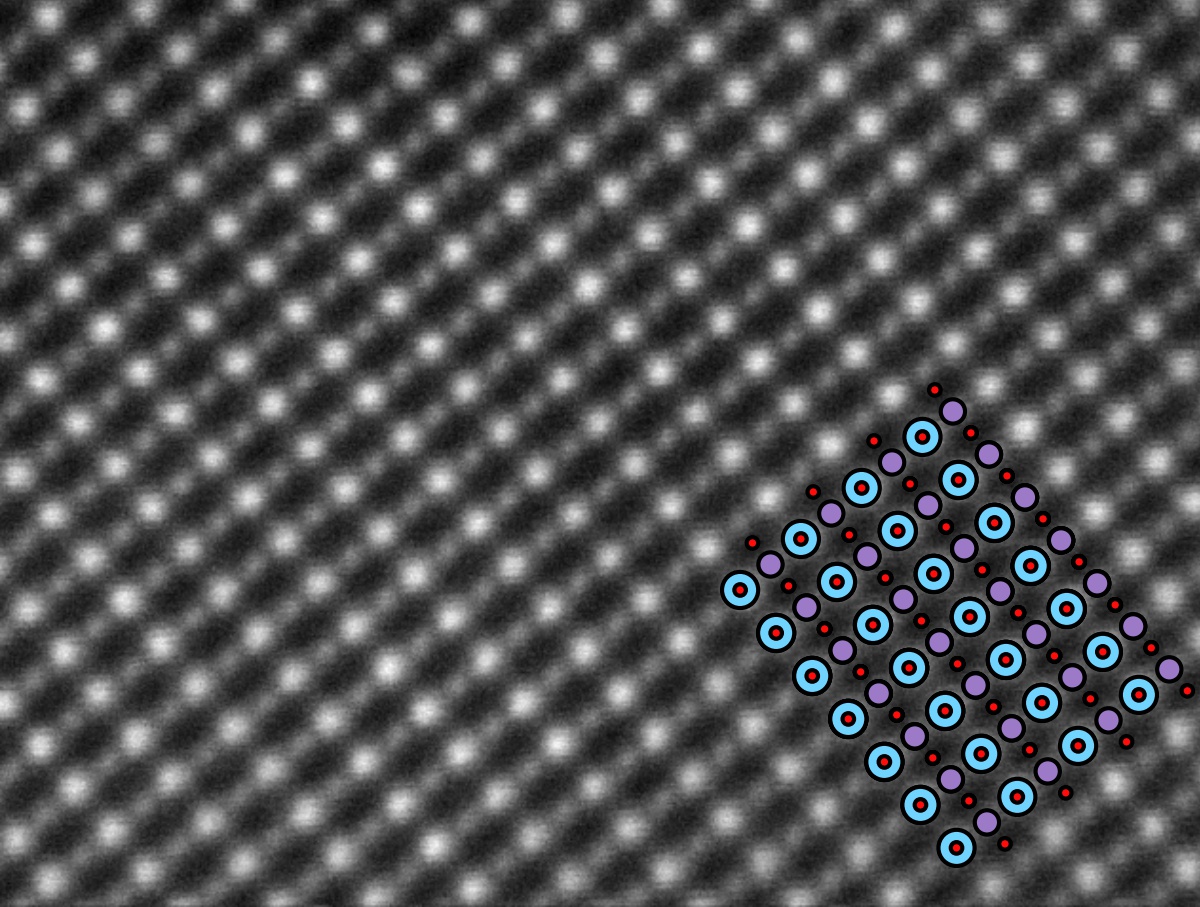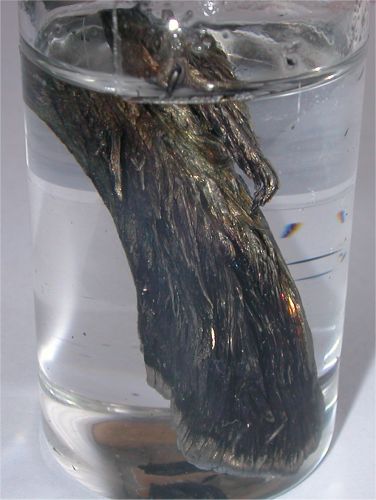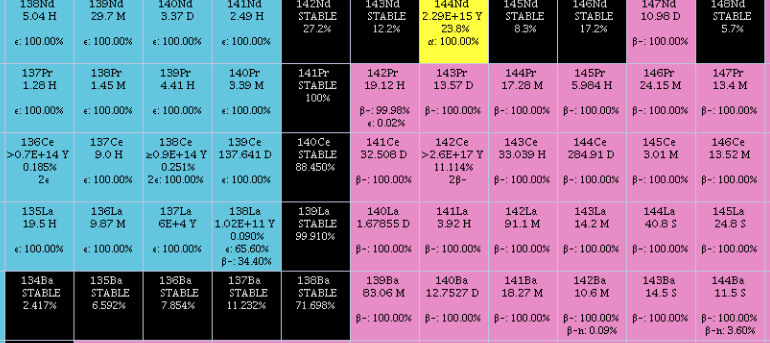|
Lanthanum Strontium Manganite
Lanthanum strontium manganite (LSM or LSMO) is an oxide ceramic material with the general formula La1−xSrxMnO3, where ''x'' describes the doping level. It has a perovskite-based crystal structure, which has the general form ABO3. In the crystal, the 'A' sites are occupied by lanthanum and strontium atoms, and the 'B' sites are occupied by the smaller manganese atoms. In other words, the material consists of lanthanum manganite with some of the lanthanum atoms substitutionally doped with strontium atoms. The strontium (valence 2+) doping on lanthanum (valence 3+) introduces extra holes in the valence band and thus increases electronic conductivity. Depending on the x value in La1−xSrxMnO3, the unit cell of LSMO can be rhombohedral, cubic, or hexagonal. This change in the unit cell is explained on the basis of the Goldschmidt tolerance factor for perovskites. The change in the oxidation state of the Mn cation in LSMO can be readily observed through the position of the XPS pe ... [...More Info...] [...Related Items...] OR: [Wikipedia] [Google] [Baidu] |
Scanning Transmission Electron Microscopy La07sr03mno
Scan, SCAN or Scanning may refer to: Science and technology Computing and electronics * Graham scan, an algorithm for finding the convex hull of a set of points in the plane * 3D scanning, of a real-world object or environment to collect three dimensional data * Counter-scanning, in physical micro and nanotopography measuring instruments like scanning probe microscope * Elevator algorithm or SCAN, a disk scheduling algorithm * Image scanning, an optical scan of images, printed text, handwriting or an object * Optical character recognition, optical recognition of printed text or printed sheet music * Port scanner, in computer networking * Prefix sum, an operation on lists that is also known as the scan operator * Raster scan, the rectangular pattern of image capture and reconstruction in television * Scan chain, a type of manufacturing test used with integrated circuits * Scan line, one line in a raster scanning pattern * Screen reading, on computers to quickly locate text elements ... [...More Info...] [...Related Items...] OR: [Wikipedia] [Google] [Baidu] |
Thermal Expansion Coefficient
Thermal expansion is the tendency of matter to increase in length, area, or volume, changing its size and density, in response to an increase in temperature (usually excluding phase transitions). Substances usually contract with decreasing temperature (thermal contraction), with rare exceptions within limited temperature ranges (''negative thermal expansion''). Temperature is a monotonic function of the average molecular kinetic energy of a substance. As energy in particles increases, they start moving faster and faster, weakening the intermolecular forces between them and therefore expanding the substance. When a substance is heated, molecules begin to vibrate and move more, usually creating more distance between themselves. The relative expansion (also called strain) divided by the change in temperature is called the material's coefficient of linear thermal expansion and generally varies with temperature. Prediction If an equation of state is available, it can be used to ... [...More Info...] [...Related Items...] OR: [Wikipedia] [Google] [Baidu] |
Ceramic Materials
A ceramic is any of the various hard, brittle, heat-resistant, and corrosion-resistant materials made by shaping and then firing an inorganic, nonmetallic material, such as clay, at a high temperature. Common examples are earthenware, porcelain, and brick. The earliest ceramics made by humans were fired clay bricks used for building house walls and other structures. Other pottery objects such as pots, vessels, vases and figurines were made from clay, either by itself or mixed with other materials like silica, hardened by sintering in fire. Later, ceramics were glazed and fired to create smooth, colored surfaces, decreasing porosity through the use of glassy, amorphous ceramic coatings on top of the crystalline ceramic substrates. Ceramics now include domestic, industrial, and building products, as well as a wide range of materials developed for use in advanced ceramic engineering, such as semiconductors. The word ''ceramic'' comes from the Ancient Greek word (), meaning "of ... [...More Info...] [...Related Items...] OR: [Wikipedia] [Google] [Baidu] |
Strontium Compounds
Strontium is a chemical element; it has symbol Sr and atomic number 38. An alkaline earth metal, it is a soft silver-white yellowish metallic element that is highly chemically reactive. The metal forms a dark oxide layer when it is exposed to air. Strontium has physical and chemical properties similar to those of its two vertical neighbors in the periodic table, calcium and barium. It occurs naturally mainly in the minerals celestine and strontianite, and is mostly mined from these. Both strontium and strontianite are named after Strontian, a village in Scotland near which the mineral was discovered in 1790 by Adair Crawford and William Cruickshank; it was identified as a new element the next year from its crimson-red flame test color. Strontium was first isolated as a metal in 1808 by Humphry Davy using the then newly discovered process of electrolysis. During the 19th century, strontium was mostly used in the production of sugar from sugar beets (see strontian process ... [...More Info...] [...Related Items...] OR: [Wikipedia] [Google] [Baidu] |
Lanthanum Compounds
Lanthanum is a chemical element; it has symbol La and atomic number 57. It is a soft, ductile, silvery-white metal that tarnishes slowly when exposed to air. It is the eponym of the lanthanide series, a group of 15 similar elements between lanthanum and lutetium in the periodic table, of which lanthanum is the first and the prototype. Lanthanum is traditionally counted among the rare earth elements. Like most other rare earth elements, its usual oxidation state is +3, although some compounds are known with an oxidation state of +2. Lanthanum has no biological role in humans but is used by some bacteria. It is not particularly toxic to humans but does show some antimicrobial activity. Lanthanum usually occurs together with cerium and the other rare earth elements. Lanthanum was first found by the Swedish chemist Carl Gustaf Mosander in 1839 as an impurity in cerium nitrate – hence the name ''lanthanum'', from the ancient Greek (), meaning 'to lie hidden'. Although it ... [...More Info...] [...Related Items...] OR: [Wikipedia] [Google] [Baidu] |
Magnetic Tunnel Junction
Tunnel magnetoresistance (TMR) is a magnetoresistance, magnetoresistive effect that occurs in a magnetic tunnel junction (MTJ), which is a component consisting of two ferromagnets separated by a thin Insulator (electrical), insulator. If the insulating layer is thin enough (typically a few nanometres), electrons can Quantum tunneling, tunnel from one ferromagnet into the other. Since this process is forbidden in classical physics, the tunnel magnetoresistance is a strictly Quantum mechanics, quantum mechanical phenomenon, and lies in the study of spintronics. Magnetic tunnel junctions are manufactured in thin film technology. On an industrial scale the film deposition is done by magnetron sputter deposition; on a laboratory scale molecular beam epitaxy, pulsed laser deposition and electron beam physical vapor deposition are also utilized. The junctions are prepared by photolithography. Phenomenological description The direction of the two magnetizations of the ferromagnetic film ... [...More Info...] [...Related Items...] OR: [Wikipedia] [Google] [Baidu] |
Solid Oxide Fuel Cell
A solid oxide fuel cell (or SOFC) is an Electrochemistry, electrochemical conversion device that produces electricity directly from oxidizing a fuel. Fuel cells are characterized by their electrolyte material; the SOFC has a solid oxide or ceramic electrolyte. Advantages of this class of fuel cells include high combined heat and power efficiency, long-term stability, fuel flexibility, low emissions, and relatively low cost. The largest disadvantage is the high operating temperature which results in longer start-up times and mechanical and chemical compatibility issues. Introduction Solid oxide fuel cells are a class of fuel cells characterized by the use of a solid oxide material as the electrolyte. SOFCs use a solid oxide electrolyte to conduct negative oxygen ions from the cathode to the anode. The electrochemical oxidation of the hydrogen, carbon monoxide or other organic intermediates by oxygen ions thus occurs on the anode side. More recently, proton-conducting SOFCs (PC-S ... [...More Info...] [...Related Items...] OR: [Wikipedia] [Google] [Baidu] |
Polaron
A polaron is a quasiparticle used in condensed matter physics to understand the interactions between electrons and atoms in a solid material. The polaron concept was proposed by Lev Landau in 1933 and Solomon Pekar in 1946 to describe an electron moving in a dielectric crystal where the ions, atoms displace from their equilibrium positions to effectively screen the charge of an electron, known as a phonon cloud. This lowers the electron mobility and increases the electron's effective mass (solid-state physics), effective mass. The general concept of a polaron has been extended to describe other interactions between the electrons and ions in metals that result in a bound state, or a lowering of energy compared to the non-interacting system. Major theoretical work has focused on solving Herbert Fröhlich, Fröhlich and Holstein hamiltonian (quantum mechanics), Hamiltonians. This is still an active field of research to find exact numerical solutions to the case of one or two electro ... [...More Info...] [...Related Items...] OR: [Wikipedia] [Google] [Baidu] |
Curie Temperature
In physics and materials science, the Curie temperature (''T''C), or Curie point, is the temperature above which certain materials lose their permanent magnetic properties, which can (in most cases) be replaced by induced magnetism. The Curie temperature is named after Pierre Curie, who showed that magnetism is lost at a critical temperature. The force of magnetism is determined by the magnetic moment, a dipole moment within an atom that originates from the angular momentum and spin of electrons. Materials have different structures of intrinsic magnetic moments that depend on temperature; the Curie temperature is the critical point at which a material's intrinsic magnetic moments change direction. Permanent magnetism is caused by the alignment of magnetic moments, and induced magnetism is created when disordered magnetic moments are forced to align in an applied magnetic field. For example, the ordered magnetic moments (ferromagnetic, Figure 1) change and become disordered ( ... [...More Info...] [...Related Items...] OR: [Wikipedia] [Google] [Baidu] |
Spintronics
Spintronics (a portmanteau meaning spin transport electronics), also known as spin electronics, is the study of the intrinsic spin of the electron and its associated magnetic moment, in addition to its fundamental electronic charge, in solid-state devices. The field of spintronics concerns spin-charge coupling in metallic systems; the analogous effects in insulators fall into the field of multiferroics. Spintronics fundamentally differs from traditional electronics in that, in addition to charge state, electron spins are used as a further degree of freedom, with implications in the efficiency of data storage and transfer. Spintronic systems are most often realised in dilute magnetic semiconductors (DMS) and Heusler alloys and are of particular interest in the field of quantum computing and neuromorphic computing, upon which leads to integrated research requirements around Hyperdimensional Computation. History Spintronics emerged from discoveries in the 1980s concerning spi ... [...More Info...] [...Related Items...] OR: [Wikipedia] [Google] [Baidu] |
Half-metal
A half-metal is any substance that acts as a conductor to electrons of one spin orientation, but as an insulator or semiconductor to those of the opposite orientation. Although all half-metals are ferromagnetic (or ferrimagnetic), most ferromagnets are not half-metals. Many of the known examples of half-metals are oxides, sulfides, or Heusler alloys. Types of half-metallic compounds theoretically predicted so far include some Heusler alloys, such as , NiMnSb, and PtMnSb; some Si-containing half–Heusler alloys with Curie temperatures over 600 K, such as NiCrSi and PdCrSi; some transition-metal oxides, including rutile structured ; some perovskites, such as and ; and a few more simply structured zincblende (ZB) compounds, including CrAs and superlattices. NiMnSb and have been experimentally determined to be half-metals at very low temperatures. In half-metals, the valence band for one spin orientation is partially filled while there is a gap in the density of states for the oth ... [...More Info...] [...Related Items...] OR: [Wikipedia] [Google] [Baidu] |




